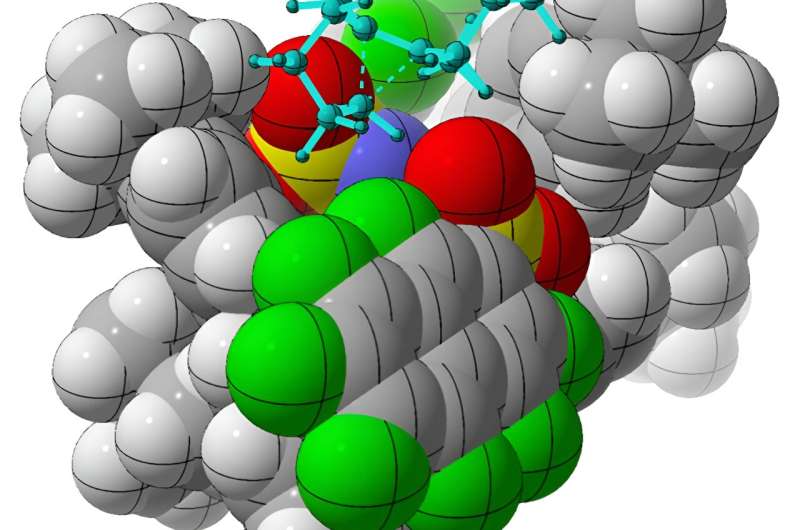This article has been reviewed according to Science X's editorial process and policies. Editors have highlighted the following attributes while ensuring the content's credibility:
fact-checked
peer-reviewed publication
trusted source
proofread
Researchers report successful synthesis of specific chiral molecules using rearrangements of simple hydrocarbons

In nature, organic molecules are either left- or right-handed, but synthesizing molecules with a specific "handedness" in a lab is hard to do. Make a drug or enzyme with the wrong "handedness," and it just won't work. Now chemists at the University of California, Davis, are getting closer to mimicking nature's chemical efficiency through computational modeling and physical experimentation.
In a study appearing Jan. 10 in Nature, Professor Dean Tantillo, graduate students William DeSnoo and Croix Laconsay, and colleagues at the Max Planck Institute in Germany report the successful synthesis of specific chiral ("handed") molecules using rearrangements of simple hydrocarbons in the presence of complex organic catalysts. Most biological compounds, including many prescription drugs, are chiral.
Tantillo and colleagues hope the findings will enable scientists to better harness hydrocarbons for a variety of purposes, such as precursors to medicines and materials.
"The novelty of this paper is that this is really the first time, to my knowledge, that someone has been able to get a carbocation shift that makes one of the mirror image products rather than the other with high selectivity," Tantillo said.
Little balls of grease
In chemistry, chirality is a property that refers to a pair of molecules that share atomic makeup but are mirror images of each other. Like your left and right hands, they can't be superimposed on each other.
"Synthetic chemists often want to make molecules that come in mirror image forms, but they only want one of them," Tantillo said. "For example, if you want to make a drug molecule, often you need one of the two chiral forms to bind selectively to a protein or enzyme target."
Achieving this can be difficult in a lab setting because such molecules, according to Tantillo, are often like "little balls of grease with some positive charge smeared around them."
The greasy-like nature of these molecules typically makes binding by a chemical catalyst in one orientation over another difficult due to the lack of charged groups for the catalyst to grab on to.
But the researchers found a solution. Using a chiral organic acid, imidodiphosphorimidate, as a catalyst, the team successfully performed rearrangements of achiral alkenyl cycloalkanes, producing chiral molecules of interest called cycloalkenes. Using computational methods, Tantillo and colleagues deduced how the catalyst selectively produces one chiral form over the other.
Similarities to nature
Tantillo said that the resulting reaction is similar to how enzymes that make hydrocarbon products called terpenes behave in nature. Part of Tantillo's research concerns mapping terpene reaction pathways using quantum mechanical methods.
"If there are multiple possible pathways to a product, then every time you stop at an intermediate on that pathway, you have the possibility to get byproducts that come from that intermediate," he said. "So it is important to know when and why a carbocation wants to stop en route to a given terpene if one wants to understand and ultimately re-engineer terpene-forming enzymes."
The new method could in principle be harnessed to produce both natural molecules and nonnatural molecules.
"Whether these things will ever be done is hard to say, but petroleum is a source of a lot of hydrocarbons, and if you could catalytically turn those into molecules with defined chirality, you've increased the value of those molecules," Tantillo said.
Additional co-authors are: Vijay Wakchaure, Markus Leutzsch and Benjamin List, Max Planck Institut für Kohlenforschung, Mülheim an der Ruhr, Germany; and Nobuya Tsuji, Hokkaido University, Sapporo, Japan.
More information: Vijay N. Wakchaure et al, Catalytic asymmetric cationic shifts of aliphatic hydrocarbons, Nature (2024). DOI: 10.1038/s41586-023-06826-7
Journal information: Nature
Provided by UC Davis





















